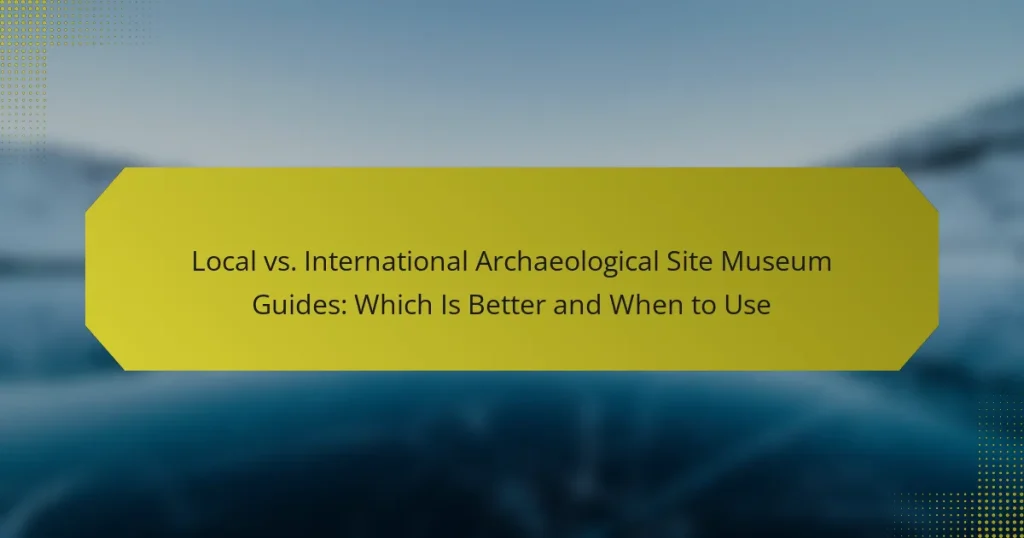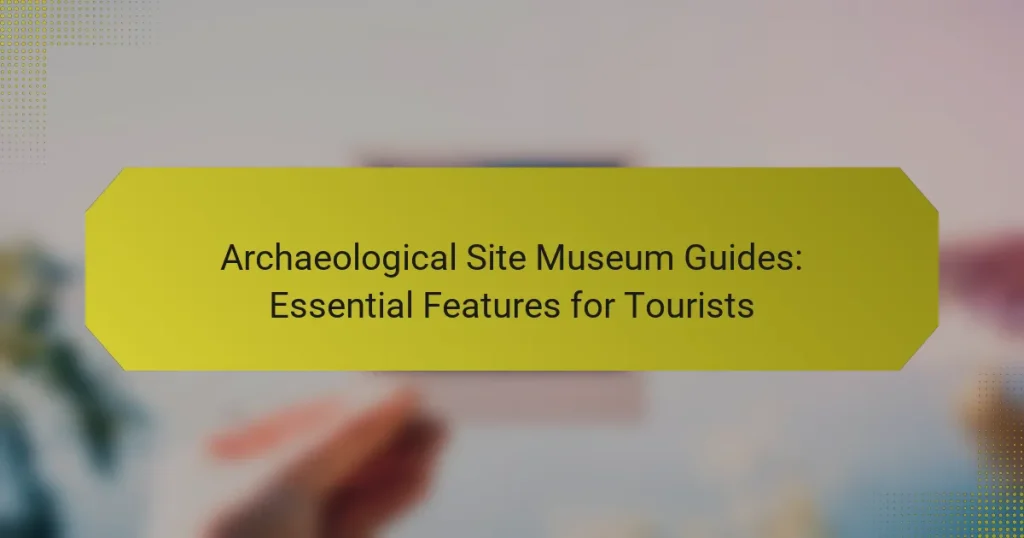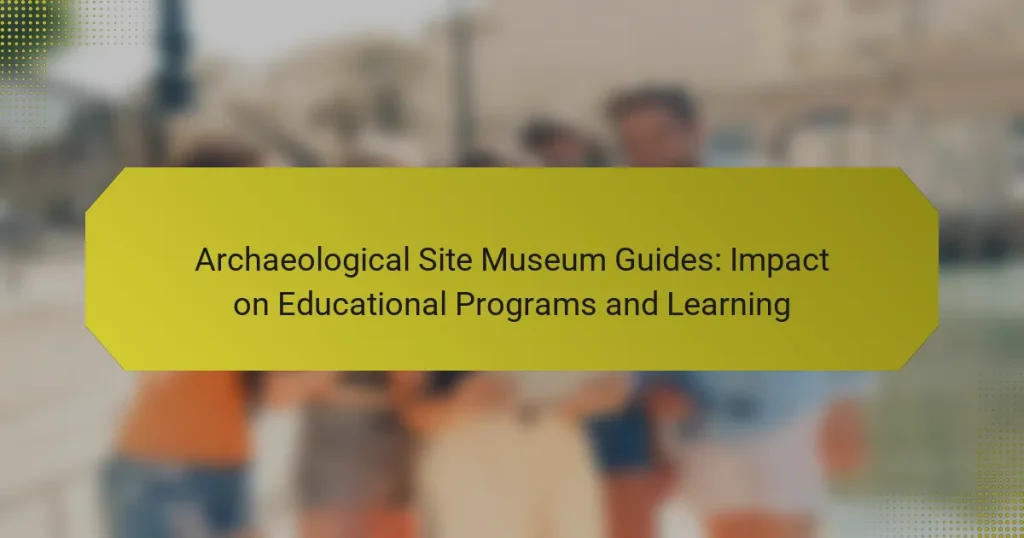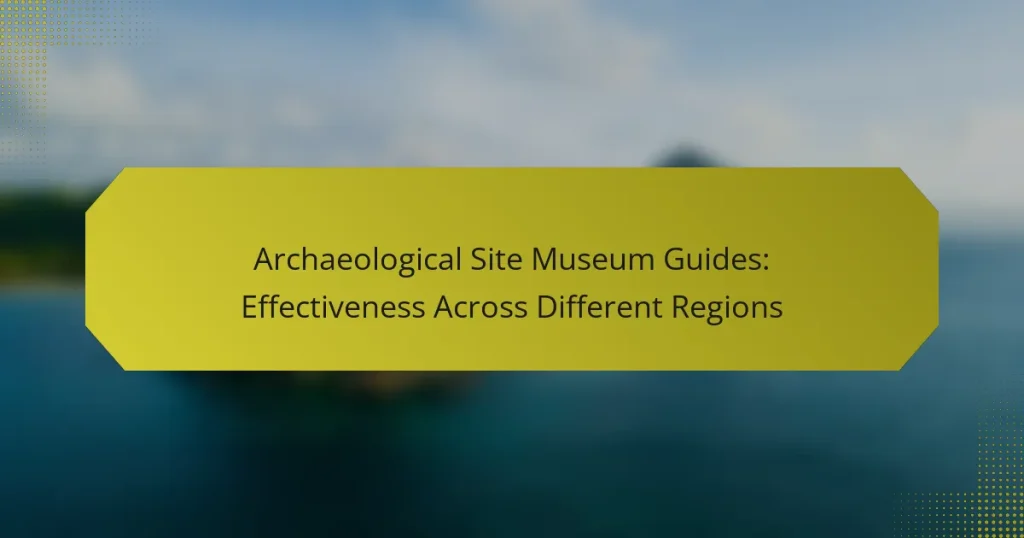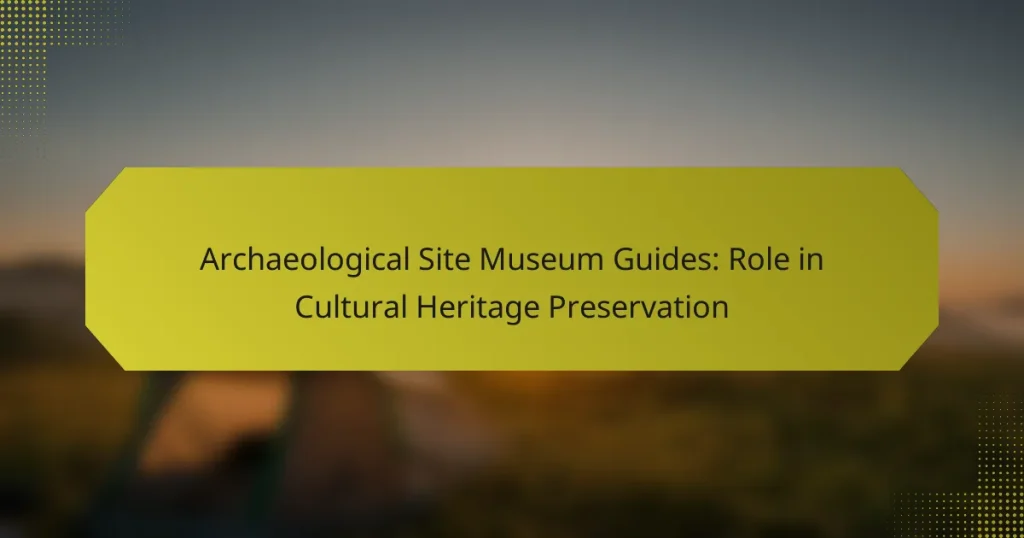Archaeological site museums are vital for exploring and understanding ancient cultures through their significant historical artifacts. Renowned institutions like the British Museum, the Louvre, and the Acropolis Museum offer unique collections that enrich visitors’ experiences. When choosing a museum to visit, consider factors such as location, collection focus, and visitor feedback to ensure a rewarding journey into the past.
Archaeological Site Museum Guides: Essential Features for Tourists
Archaeological Site Museum Guides: Impact on Educational Programs and Learning
Archaeological Site Museum Guides: Effectiveness Across Different Regions
Archaeological Site Museum Guides: Role in Cultural Heritage Preservation
Archaeological Site Museum Guides: Enhancing Visitor Experience and Engagement
Archaeological Site Museum Guides: Future Trends in Digital Tourism
What are the best archaeological site museums in Europe?
The best archaeological site museums in Europe showcase significant historical artifacts and provide insights into ancient cultures. Notable examples include the British Museum, the Louvre, and the Acropolis Museum, each offering unique collections and experiences for visitors.
The British Museum
The British Museum, located in London, houses a vast collection of world art and artifacts, including the Rosetta Stone and the Elgin Marbles. It offers free admission, making it accessible to a wide audience.
Visitors can explore various exhibitions that cover ancient civilizations from Egypt to Mesopotamia. Guided tours are available, providing deeper insights into the collections and their historical contexts.
The Louvre
The Louvre in Paris is one of the largest and most visited museums globally, famous for housing the Mona Lisa and the Venus de Milo. Its extensive collection spans thousands of years and includes artifacts from ancient Egypt, Greece, and Rome.
Entry fees apply, but visitors can purchase tickets online to avoid long queues. The museum also offers audio guides and guided tours to enhance the visitor experience.
The Acropolis Museum
Located in Athens, the Acropolis Museum focuses on the archaeological findings from the Acropolis site. It features a modern design and stunning views of the Acropolis itself, making it a must-visit for history enthusiasts.
The museum’s exhibits include sculptures and artifacts from the Parthenon, providing context for their historical significance. Tickets can be purchased at the entrance or online, and guided tours are available for a more comprehensive understanding.
The National Archaeological Museum of Athens
This museum is one of the most important archaeological museums in Greece, showcasing a vast collection of ancient Greek art and artifacts, including the famous Mask of Agamemnon. It offers insight into the development of Greek civilization from prehistoric times to the Roman period.
Admission fees are reasonable, and the museum often hosts temporary exhibitions that highlight specific themes or periods. Audio guides are available to enhance the visitor experience.
The Pergamon Museum
Situated in Berlin, the Pergamon Museum is renowned for its monumental architecture and artifacts, including the Pergamon Altar and the Ishtar Gate of Babylon. It is part of the Museum Island, a UNESCO World Heritage site.
Visitors should consider purchasing a combination ticket for access to multiple museums on the island. The museum also offers guided tours that delve into the history and significance of its collections.
How to choose an archaeological site museum to visit?
Choosing an archaeological site museum involves considering factors like location, collection focus, and visitor feedback. A well-informed decision enhances your experience and ensures you visit a site that aligns with your interests.
Consider location and accessibility
When selecting an archaeological site museum, assess its location and how easily you can reach it. Look for museums that are conveniently situated near major transport links or within walking distance of other attractions.
Consider the accessibility options available, especially if you have mobility concerns. Check if the museum provides facilities such as ramps, elevators, or guided tours tailored for individuals with disabilities.
Evaluate the museum’s collection focus
Different archaeological site museums may specialize in various themes, such as ancient civilizations, regional history, or specific artifacts. Determine what interests you most and seek out museums that align with those themes.
Review the collection highlights on the museum’s website or promotional materials. This can help you gauge whether the exhibits will be engaging and informative for your visit.
Check visitor reviews and ratings
Before visiting an archaeological site museum, read visitor reviews on platforms like TripAdvisor or Google. These reviews often provide insights into the quality of exhibits, the knowledge of staff, and overall visitor satisfaction.
Look for patterns in the feedback. If multiple reviews mention issues like overcrowding or poor maintenance, consider those factors in your decision-making process. Aim for museums with consistently high ratings to enhance your experience.
What are the benefits of visiting archaeological site museums?
Visiting archaeological site museums offers numerous advantages, including enhanced understanding of historical contexts and cultural heritage. These museums provide immersive experiences that foster appreciation for ancient civilizations and their contributions to modern society.
Educational experiences
Archaeological site museums serve as valuable educational resources, offering visitors insights into past societies through artifacts, exhibits, and guided tours. Many museums provide programs tailored for different age groups, making learning accessible and engaging for everyone.
Interactive displays and workshops often allow visitors to participate in hands-on activities, such as pottery making or ancient writing techniques. This experiential learning can deepen understanding and retention of historical knowledge.
Cultural enrichment
Exploring archaeological site museums enriches cultural awareness by showcasing the diversity of human experience throughout history. Visitors gain exposure to various traditions, art forms, and social structures that have shaped different civilizations.
These museums often highlight the significance of cultural preservation and the importance of respecting heritage. Engaging with diverse cultures can foster empathy and appreciation for global interconnectedness.
Engagement with history
Archaeological site museums provide a unique opportunity to engage with history in a tangible way. By viewing artifacts and learning about their origins, visitors can connect with the lives of people from different eras.
Many museums offer special exhibitions or events that focus on specific historical themes, allowing for a deeper exploration of particular topics. This engagement can inspire curiosity and motivate further research into historical subjects of interest.
What are the common features of archaeological site museums?
Archaeological site museums typically feature exhibition galleries, interactive displays, and guided tours, all designed to enhance visitor understanding of the site’s historical significance. These elements work together to provide an engaging and educational experience for guests of all ages.
Exhibition galleries
Exhibition galleries are central to archaeological site museums, showcasing artifacts and displays that narrate the history of the site. These galleries often include items such as pottery, tools, and artwork, arranged thematically to illustrate cultural practices and societal developments.
When visiting, look for well-labeled exhibits that provide context and background information. Consider taking notes or photographs (if permitted) to help remember key details about the artifacts and their historical relevance.
Interactive displays
Interactive displays are increasingly common in archaeological site museums, allowing visitors to engage with the material in hands-on ways. These may include touchscreens, virtual reality experiences, or physical replicas that encourage exploration and learning.
When using interactive displays, take your time to fully engage with the content. These features can provide deeper insights into archaeological methods and findings, making the experience more memorable and informative.
Guided tours
Guided tours offer structured visits led by knowledgeable staff or volunteers, providing in-depth information about the site and its artifacts. These tours can vary in length, typically lasting from 30 minutes to a couple of hours, depending on the museum’s size and the depth of information offered.
To maximize your experience, consider joining a guided tour at the start of your visit. This can help you understand the layout of the museum and highlight key exhibits to explore further on your own. Always check the schedule for tour times, as they may vary throughout the day.
What are the ticket prices for archaeological site museums?
Ticket prices for archaeological site museums can vary widely based on location, the significance of the site, and the type of exhibition. Generally, prices range from free entry to modest fees, often between $5 to $20 USD for standard admission.
Free entry options
Many archaeological site museums offer free entry on specific days or during certain hours, allowing visitors to explore without a cost. Some institutions may provide free access for children under a certain age or for local residents on designated days.
Additionally, certain cultural events or community days may feature free admission, making it a great opportunity to visit. Always check the museum’s website or contact them directly for the latest information on free entry opportunities.
Standard admission fees
Standard admission fees for archaeological site museums typically range from $5 to $20 USD, depending on the museum’s location and the exhibits on display. Larger, more renowned sites may charge higher fees, while smaller or local museums often keep costs lower to encourage community engagement.
Some museums may offer special pricing for family passes or group rates, which can provide savings for larger parties. It’s advisable to review the museum’s pricing structure online before your visit to plan accordingly.
Discounts for students and seniors
Many archaeological site museums provide discounts for students and seniors, often reducing admission fees by 50% or more. To qualify, students typically need to present a valid student ID, while seniors may need to show proof of age.
These discounts can make visiting more affordable, especially for educational groups or older visitors. Always inquire about available discounts when purchasing tickets, as policies may vary by location.
